Stratonicea
Q1361187Stratonicea (Greek Στρατoνίκεια): an ancient city in Caria, modern Eskihisar.
History
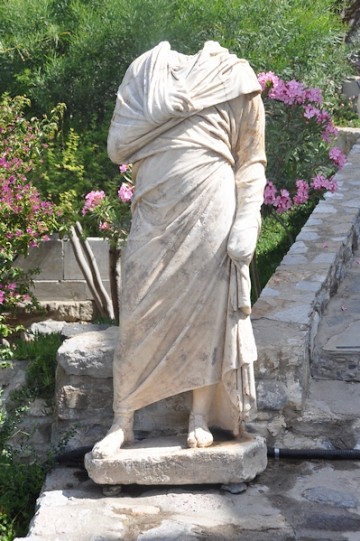
Founded early in the third century BCE by the Seleucid king Antiochus I Soter, and named in honor of his wife Stratonice, the new city seems to have been built on the site of an older Carian town, Chrysaoris or Idrias.note Idrias appears to figure in the Athenian tribute lists as Edrieis. In 425 BCE it was, together with Euromos and Hymessos, assessed at six talents, a comparatively high sum.
Although founded by a Seleucid king and settled with Greeks and Macedonians, Stratonicea was admitted to a confederation of Carian towns that is known as the Chrysaoric League.note Its representatives met at the temple of Zeus Chrysaoreus ("of the golden sword"), which is said to have been near the city. The earliest evidence for this League is an inscription of 267 BCE, but it may have been in existence much earlier.
Strabo of Amasia says that Stratonicea was "adorned with costly improvements by the Seleucid kings",note although within a few years it was presented by them to Rhodes.note The Rhodians lost it on some unrecorded occasion, but recovered it in 197 BCE and kept the city until 167, when all of Caria was declared free by the Roman Senate. In 130, it was the scene of the final surrender of the Attalid pretender Aristonicus, and in 40 BCE was attacked unsuccessfully by Labienus and his Parthian troops.
A free city in the Roman Empire,note Stratonicea continued to flourish. The emperor Augustus helped to rebuild the temple of Hecate in nearby Lagina, while Hadrian supported the town with some new buildings. The statement by Stephanus of Byzantium that Stratonicea was renamed "Hadrianopolis", appears to be the result of a confusion with another city with the same name. Stratonicean coinage extends from the liberation from Rhodes in 167 to the time of the emperor Gallienus (r.253-268). In late Antiquity, it was the see of a bishop.
Sights
The acropolis hill is in the south, and has a circuit wall round the summit. On a terrace on its north slope are the ruins of a small temple dedicated to the Roman ruler cult. Immediatley below it is a large theater. The cavea has a single diazoma and nine cunei, and the foundations of the stage building survive underground. The theater may have accomodated some 10,000 spectators.
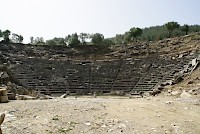
In the inhabited part of the city, on the level ground to the north, the most conspicuous ruin is that of the Serapeum, a massive building dating from about 200 CE. Its lower parts are buried, but the walls are standing to a considerable height in solid broad-and-narrow masonry; they bear many inscriptions. Of the temenos, some 100 meters square, little survives apart from the entrance gate on the west, which stands complete with lintel.
The city wall, originally ca. 1,6 km long, has almost totally disappeared, but part of the main city gate on the north is standing: a single-arched gateway. The piers remain, also in broad-and-narrow masonry, and the spring of the arch above them. Just inside, a single column survives from the interior colonnade; it is unfluted and of the Corinthian order. At the north-east corner of the city is a large fortress some eighty meters long, built of large squared blocks regularly coursed, but repaired in places with reused material.
The agora lay west of the Serapeum, but nothing remains but a row of blocks on its eastern side. To the north are the ruins of a building of unknown purpose and unusual form; it has a long wall of good regular masonry to which part of a curved wall is attached on the south side.
The temple of Zeus Chrysaoreus has not been located. There are some rather scanty ancient remains near the main road about four kiliometers east of Eskihisar which might be those of a temple; if so, this may be the spot called White Pillars by Herodotus.note
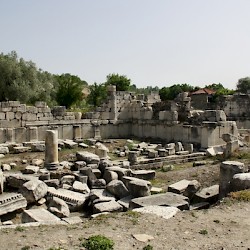 Stratonicea, Gymnasium |
 Stratonicea, Bouleuterion |
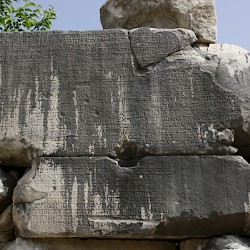 Stratonicea, Bouleuterion, inscription |
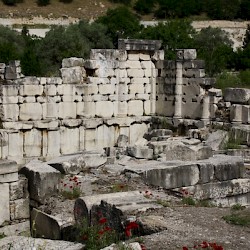 Stratonicea, Gymnasium |
Getting there
The site of Stratonicea is easily to reach from the main road from Milas to Eskihisar and the visit is free and without danger.